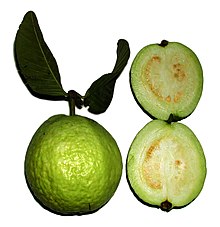Psidium guajava
| Common guava | |
|---|---|
 |
|
| Common guava (Psidium guajava) fruit | |
| Scientific classification | |
| Kingdom: | Plantae |
| (unranked): | Angiosperms |
| (unranked): | Eudicots |
| (unranked): | Rosids |
| Order: | Myrtales |
| Family: | Myrtaceae |
| Subfamily: | Myrtoideae |
| Tribe: | Myrteae |
| Genus: | Psidium |
| Species: | P. guajava |
| Binomial name | |
|
Psidium guajava L. |
|
Psidium guajava, the common guava,yellow guava, or lemon guava (known as goiaba in Portuguese and guayaba in Spanish) is an evergreen shrub or small tree native to the Caribbean, Central America and South America. It is easily pollinated by insects; in culture, mainly by the common honey bee, Apis mellifera.
Widely cultivated in tropical and subtropical regions around the world, guava fruits can range in size from as small as an apricot to as large as a grapefruit. Various cultivars have white, pink, or red flesh, and a few also feature red (instead of green or yellow) skin.
When cultivated from seed, guavas are notable for an extremely slow growth rate for several months, before a very rapid acceleration in growth rate takes over. From seed, common guavas may bloom and set fruit in as few as two years or as many as eight. Cuttings and grafting are more commonly used as a propagation method in commercial groves. Highly adaptable, guavas can be easily grown as container plants in temperate regions, though their ability to bloom and set fruit is somewhat less predictable. In some tropical locales, guavas can become invasive. It has become a major problem in the Galápagos Islands.
The plant is used in many different shampoo products for its scent. It is also becoming a popular bonsai species and is currently quite popular in India and Eastern Asia.
Owing to its hardy nature, guava is grown successfully in tropical and subtropical regions up to 1,500 m (4,900 ft) above mean sea-level. Best quality guavas are obtained where low night temperatures, 10 °C (50 °F), prevail during winter. It tolerates high temperatures and drought conditions in North India during summers but it is susceptible to severe frost as it can kill the young plants. An annual rainfall of about 100 cm (39 in) is sufficient during the rainy season (July–September). The rains during harvesting period, however, deteriorate the quality of fruits.
Guava is cultivated on varied types of soils- heavy clay to very light sandy soils. Nevertheless, very good quality guavas are produced in river-basins. It tolerates a soil pH of 4.5-8.2. Maximum concentration of its feeding roots is available up to 25 cm (9.8 in) soil depth. Thus the top soil should be quite rich to provide enough nutrients for accelerating new growth which bears fruits.
...
Wikipedia
